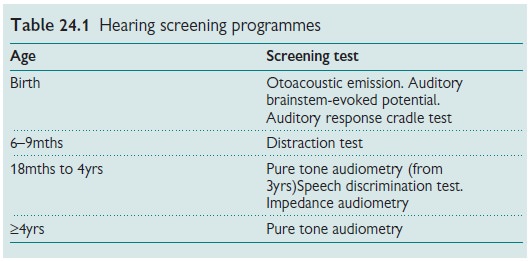Chapter: Paediatrics: Special senses
Paediatrics: Hearing assessment
Hearing assessment
A foetus will respond to sound in
the latter part of pregnancy (from 3rd trimester). At birth, the baby will
react to noise with a marked preference for voices.
Hearing screening
Specific screening questions can
be asked when evaluating hearing:
•
Birth: does baby startle to loud noise?
· 12wks:
•
Does
baby quieten to mother’s voice even when mother cannot be seen?
•
Does
baby quieten to prolonged loud noise?
•
Does
baby settle to a musical toy?
•
5mths:
•
Does
baby smile to familiar voice?
•
Does
he/she take turns to vocalize when spoken to?
•
7mths:
•
Does
baby turn to look towards a new sound?
•
Does
he/she make tuneful vocalization?
•
9mths:
•
Does
baby recognize own name?
•
Does
baby recognize and react to familiar tunes and music?
•
11mths: Will baby react to calling from
out of sight?
The early detection of hearing
loss is important. Deafness impairs speech and language development, cognitive
development, and socialization. A baby who does not startle when parents come
into view may not have heard them approach due to deafness. These children need
urgent audio-logical assessment along
with children who show absence of appropriate vocalization by age (see bullet
points in Hearing screening).
Hearing tests
All health authority areas in the
UK have a universal newborn hearing screening (UNHS) programme. UNHS involves
otoacoustic emission test-ing in the first 48hr after birth. In the test a
small earpiece is inserted into the ear canal. This delivers a sound that
evokes an emission from the ear if the cochlea is normal.
Current hearing screening programmes (Table 24.1)

There is currently some regional
variation in the type of tests used.
In line with recommendations once UNHS is in place, universal distrac-tion testing at 7–9mths will be abandoned.
The distraction test
The test is based on the principle
that a normal response is observed when sound is presented to an infant, and
the infant turns their head to lo-cate the source of the sound. Two testers are
required—one presents the sound out of the infant’s line of vision, while the
other holds the infant’s attention in a forward direction. The test involves
delivering a frequency— specific stimulus presented at quiet levels (35dB) to
the side and slightly behind an infant who is seated on a parent’s knee.
Distraction testing requires a
behavioural response and is therefore a direct test of hearing sensitivity. The
major disadvantages of this test are that an infant must be mature enough to
sit erect and head turn, and it is subject to all the common biases found in
behavioural testing of hearing. It is therefore unsuitable for neonates, which
makes identification of hearing loss before 6mths of age very difficult.
Related Topics